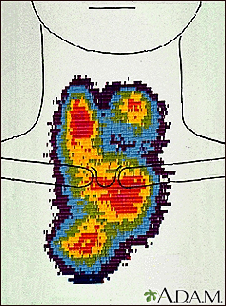Thyroid scan
Scan - thyroid; Radioactive iodine uptake and scan test - thyroid; Nuclear scan - thyroid; Thyroid nodule - scan; Goiter - scan; Hyperthyroidism - scan
A thyroid scan uses a radioactive iodine tracer to examine the structure and function of the thyroid gland. This test is often done together with a radioactive iodine uptake test.
Images


I Would Like to Learn About:
How the Test is Performed
The test is done in this way:
- You are given a pill that contains a tiny amount of radioactive iodine. After swallowing it, you wait as the iodine collects in your thyroid.
- The first scan is usually done 4 to 6 hours after you take the iodine pill. Another scan is usually done 24 hours later. During the scan, you lie on your back on a movable table. Your neck and chest are positioned under the scanner. You must lie still so that the scanner gets a clear image.
The scanner detects the location and intensity of the rays given off by the radioactive material. A computer displays images of the thyroid gland. Other scans use a substance called technetium instead of radioactive iodine.
How to Prepare for the Test
Follow instructions about not eating before the test. You may be told not to eat after midnight before your scan the next morning.
Tell your health care provider if you are taking anything that contains iodine because it may affect your test results. This includes some medicines, including thyroid and heart medicines. Supplements such as kelp also contain iodine.
Also tell your provider if you have:
- Diarrhea (may decrease absorption of the radioactive iodine)
- Had recent CT scans using intravenous iodine-based contrast (within the past 2 weeks)
- Too little or too much iodine in your diet
Remove jewelry, dentures, or other metals because they may interfere with the image.
How the Test will Feel
Some people find it uncomfortable to stay still during the test.
Why the Test is Performed
This test is done to:
- Evaluate thyroid nodules or goiter
- Find the cause of an overactive thyroid gland
- Check for thyroid cancer (rarely, since other tests are more accurate for this)
Normal Results
Normal test results will show that the thyroid appears to be the correct size, shape, and in the proper location. It is an even gray color on the computer image without darker or lighter areas.
What Abnormal Results Mean
A thyroid that is enlarged or pushed off to one side could be a sign of a tumor.
Nodules absorb more or less iodine and this will make them look darker or lighter on the scan. A nodule is usually lighter if it has not taken up the iodine (often called a cold nodule). If part of the thyroid appears lighter, it could be a thyroid problem. Nodules that are darker have taken up more iodine (often called a hot nodule). They can be overactive and may be the cause of an overactive thyroid.
The computer will also show the percentage of iodine that has collected in your thyroid gland (radioiodine uptake). If your gland collects too much iodine, it may be due to an overactive thyroid. If your gland collects too little iodine, it may be due to inflammation or other damage to the thyroid.
Risks
All radiation has possible side effects. The amount of radioactivity is very small, and there have been no documented side effects.
Women who are pregnant or breastfeeding should not have this test.
Talk to your provider if you have concerns about this test.
Considerations
The radioactive iodine leaves your body through your urine. You need not take special precautions, such as flushing twice after urinating, for 24 to 48 hours after the test because the dose of radioactive iodine is very low. Ask your provider or the radiology/nuclear medicine team performing the scan about taking precautions.
Related Information
PET scanHyperthyroidism
Cancer
Thyroid cancer
Skin nodules
Tumor
Anaplastic thyroid cancer
Simple goiter
Thyroid cancer - medullary carcinoma
Multiple endocrine neoplasia (MEN) II
Thyroid cancer - papillary carcinoma
Toxic nodular goiter
References
Mettler FA, Guiberteau MJ. Thyroid, parathyroid, and salivary glands. In: Mettler FA, Guiberteau MJ, eds. Essentials of Nuclear Medicine and Molecular Imaging. 7th ed. Philadelphia, PA: Elsevier; 2019:chap 4.
Salvatore D, Cohen R, Kopp PA, Larsen PR. Thyroid pathophysiology and diagnostic evaluation. In: Melmed S, Auchus RJ, Goldfine AB, Koenig RJ, Rosen CJ, eds. Williams Textbook of Endocrinology. 14th ed. Philadelphia, PA: Elsevier; 2020:chap 11.
Sipos JA. Thyroid imaging. In: Robertson RP, ed. DeGroot's Endocrinology. 8th ed. Philadelphia, PA: Elsevier; 2023:chap 69.
BACK TO TOPReview Date: 2/28/2024
Reviewed By: Sandeep K. Dhaliwal, MD, board-certified in Diabetes, Endocrinology, and Metabolism, Springfield, VA. Also reviewed by David C. Dugdale, MD, Medical Director, Brenda Conaway, Editorial Director, and the A.D.A.M. Editorial team.

Health Content Provider
06/01/2025
|
A.D.A.M., Inc. is accredited by URAC, for Health Content Provider (www.urac.org). URAC's accreditation program is an independent audit to verify that A.D.A.M. follows rigorous standards of quality and accountability. A.D.A.M. is among the first to achieve this important distinction for online health information and services. Learn more about A.D.A.M.'s editorial policy, editorial process and privacy policy. A.D.A.M. is also a founding member of Hi-Ethics. This site complied with the HONcode standard for trustworthy health information from 1995 to 2022, after which HON (Health On the Net, a not-for-profit organization that promoted transparent and reliable health information online) was discontinued. |
The information provided herein should not be used during any medical emergency or for the diagnosis or treatment of any medical condition. A licensed medical professional should be consulted for diagnosis and treatment of any and all medical conditions. Links to other sites are provided for information only -- they do not constitute endorsements of those other sites. © 1997- 2025 A.D.A.M., a business unit of Ebix, Inc. Any duplication or distribution of the information contained herein is strictly prohibited.
